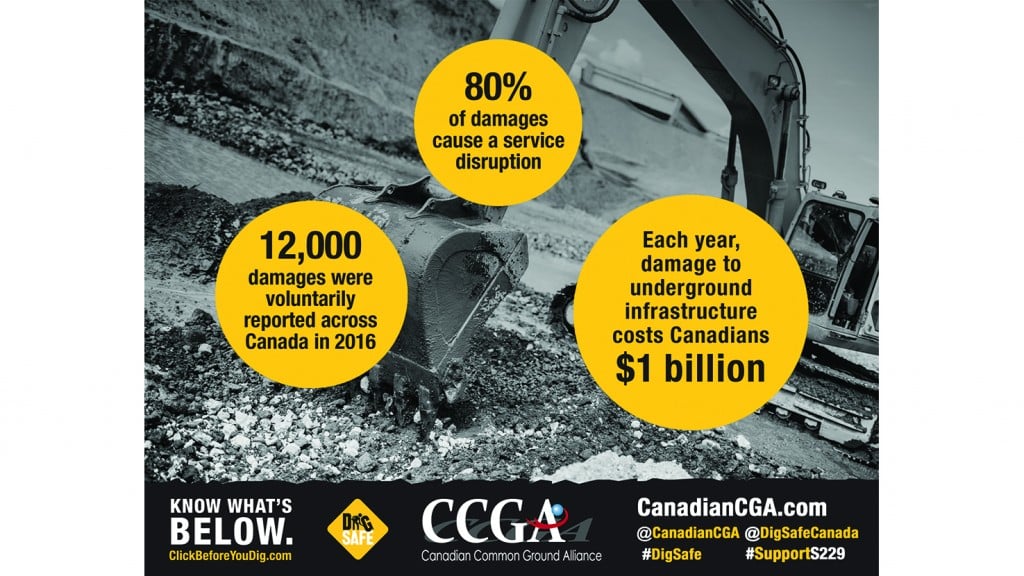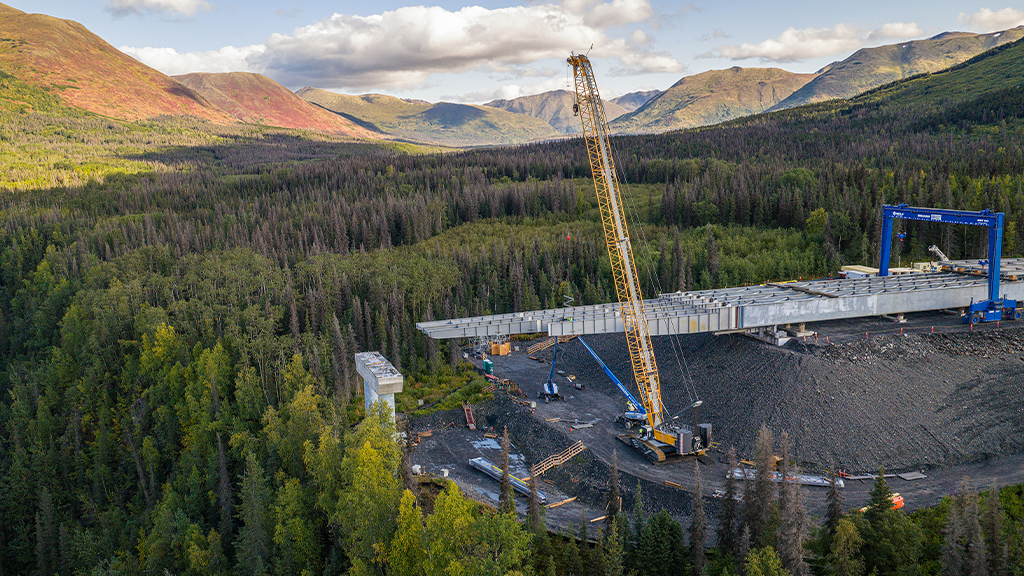
When you start up an excavator or a backhoe and begin to dig, do you ever consider the risks? Just beneath our feet are hundreds of thousands of kilometres of pipes and cables, that crisscross the country and provide the essential services that we rely on every single day. This underground infrastructure is a crucial component for the comfort, productivity and safety that we expect in our day-to-day lives: it distributes electricity, natural gas and clean drinking water, as well as cell service and internet – facilitating both electronic communication and financial transactions. Striking a buried utility line can result in inconvenient outages for entire neighbourhoods, and even cause harm to yourself or others. A damaged utility line will require expensive repairs and can result in fines, penalties and litigation.
The situation
When it comes to underground infrastructure, the old idiom "out of sight, out of mind" still seems to hold true. We expect that buried utilities are buried deeper than they are, that they are always located within the utility corridor or right-of-way, or that they enter at the back of a property instead of at the front, or vice versa. We may even think we remember where they are after having located them several years before. Sometimes these utilities are buried deep below, but other times they are located quite close to the surface. The depth of a buried utility can change over time as the result of natural forces, such as erosion, or from other dirt moving activities. New facilities may have also been installed since the last time a locate was requested.
The idiom is even more true as more of our technology becomes wireless. Whether you're browsing the internet on your phone, paying with a credit card, or listening to the radio in your car, the wireless devices that we take for granted rely on physical utility lines, whether connected to a modem in the next room, or a cell tower several kilometres away. As our cities grow - as does the Internet of Things – more and more aspects of our day-to-day lives will hinge on the availability of these services, and new infrastructure will be required to support our expected quality of life, with outdated infrastructure either being replaced or abandoned.
We simply cannot afford to leave buried utilities out of sight and out of mind. Every year, thousands of buried facilities are accidentally damaged during digging activities, with services interrupted in nearly every case. These incidents can lead to environmental contamination, personal injury, or even death. However, these accidents are avoidable if commercial and private digging projects adopt safe digging practices and use the free services provided by ClickBeforeYouDig.com to locate buried infrastructure prior to excavating.
The numbers
Every year, the Canadian Common Ground Alliance (CCGA) and its regional partners release a DIRT Report, which provides an overview of damage-related statistics in Canada, based on voluntary incident reports filed during the previous year. In 2017, there were 11,564 reported damages to underground infrastructure in Canada, and over 80 percent of these damages resulted in a disruption of service to families and businesses, which is almost 45 damages per workday.
The DIRT Report breaks these numbers down even further and helps paint a picture of a typical incident when a buried facility is damaged.
For incidents where the type of equipment was reported, backhoes and trenchers were the most common type of equipment in use (70 percent). Damages occurred most often during work on water or sewer systems (32 percent of damages where type of work was reported). However, utility work (20 percent), construction (16 percent), roadwork (15 percent), and landscaping (15 percent), were not far behind.
The leading root cause of damages, in 51 percent of incidents, was that the excavator had not requested a locate. For damages that occurred after a locate was performed, 63 percent were caused by a failure to use hand tools when required in order to properly expose the line.
The cost
When underground infrastructure is damaged, there is an immediate, noticeable and quantifiable cost incurred: the utility must be repaired, and fines and penalties may be imposed on the excavator. But damaging underground infrastructure has societal costs that go well beyond the cost of repairs.
Imagine an excavator makes a rash decision to perform a 30-metre bore shot without obtaining locates. This results in puncturing an eight-inch natural gas line, situated in a dense urban neighbourhood. Emergency services are alerted, and firefighters respond to the incident.
Because there is the possibility of an explosion, and because of the high levels of natural gas in the air, nearby buildings are evacuated for several blocks, including homes, businesses and schools, resulting in thousands of individuals having to leave the area. Electricity in the area is immediately cut off, potentially depriving homes and businesses beyond the immediate area of power. Traffic is diverted from the area, causing traffic congestion, and without power, police must direct traffic at intersections.
Utility owners quickly arrive onsite to assess the damage and the local One-Call centre is notified, dispatching an emergency locate to ensure that no other utilities in the area will be damaged during the course of repairs. Then after gas crews have capped the leak, homeowners and businesses must have their gas appliances relit before being allowed to return.
Damaging a buried utility strains emergency response resources and frequently requires evacuating nearby homes and businesses. Incidents can lead to property damage, project delays and traffic congestion, and require expensive repairs, mitigation and remediation. Without electricity or internet, local businesses are unable to perform financial transactions until these services are restored.
For this reason, the Canadian Common Ground Alliance commissioned the Centre for Interuniversity Research and Analysis of Organizations (CIRANO), to develop a societal cost formula and tool. When applied to data from the DIRT Report, this formula provides a estimate of the cost which society bears as a result of damage to underground infrastructure.
Based on the report by CIRANO, the average societal cost of a single ground disturbance incident is estimated at more than $80,000. The total estimated societal cost of damage to underground infrastructure in Canada is at least $1 billion a year.
1. Always request a locate from a One-Call centre:
Submit a locate request through ClickBeforeYouDig.com several days before you plan to start your project and your local One-Call center will notify the affected utility companies of your intent to dig. The utility companies, or professional locators working on their behalf, will visit your planned dig site to mark the approximate location of buried utility lines with paint, flags or both. Once your site has been marked, it is safe to begin digging around the marked areas.
No matter the type of project - installing a fence, planting a tree, building a deck, or excavating a new garden area - make sure to visit ClickBeforeYouDig.com several days prior to digging to have your site properly marked, and please remind your customers, as well as your friends and family, to do the same. Always click before you dig and know what's below.
2. Follow best practices:
Those that disturb the ground need access to consistent, accurate information that will help them minimize the risks of contacting buried facilities associated with ground disturbance activities, especially given the extent and complexity of the underground infrastructure and the multiplicity of regulations that affect buried facilities.
For this reason, the CCGA has developed the National Harmonized Best Practices. The CCGA Best Practices manual, developed through the commitment and consensus of stakeholders from all industries involved in preventing damage to underground infrastructure, introduces new damage prevention practices, improves existing ones and serves as an educational guide to promote damage prevention in Canada. It is available for free on the CanadianCGA.com website.
3. Take ground disturbance training:
Employers must ensure that their employees are competent to carry out their required tasks. The CCGA's regional partner, the Alberta Common Ground Alliance (ABCGA), has established the minimum standard content for two levels of ground disturbance training and has put in place an assessment process for the endorsement of ground disturbance training programs.
The Ground Disturbance 201 Standard was recently expanded to British Columbia and will soon be available in Manitoba.
A list of currently endorsed training providers is available on the ABCGA website: DigSafeAB.ca.
4. Support damage prevention legislation:
One of the most important steps for preventing damage to underground infrastructure is establishing Canada-wide damage prevention legislation. This legislation would require owners of underground infrastructure to register their buried utilities with a One-Call centre, require excavators to request a utility locate from a One-Call centre prior to digging, and require utility owners to provide the location of their underground infrastructure upon receiving a locate request.
Legislation is a necessary step for damage prevention in Canada: it ensures the safety of our workers, protects the integrity of our buried utility network and preserves our essential services.
At the moment, Ontario is the only province in Canada with established damage prevention legislation.
Mike Sullivan is the executive director for the Canadian Common Ground Alliance.



